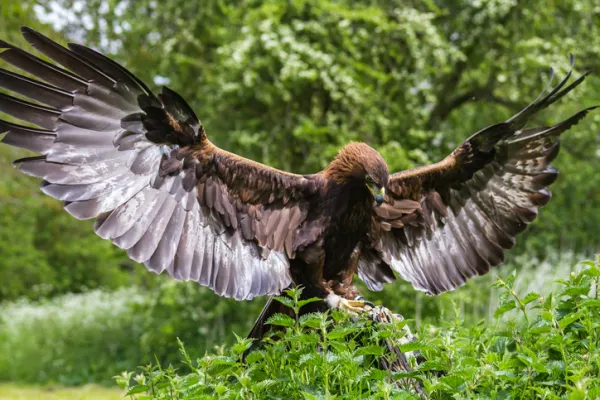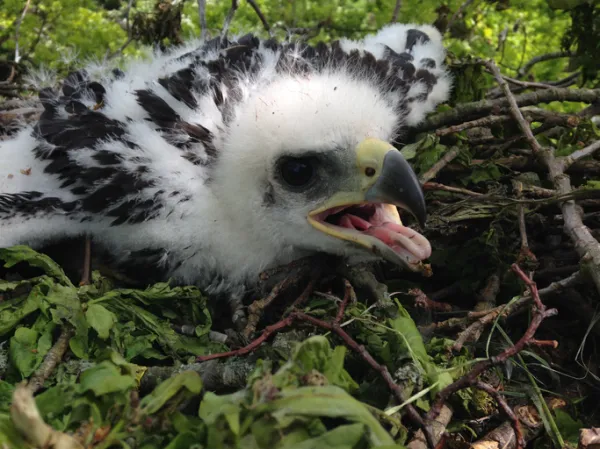The golden eagle (Aquila chrysaetos), also known as the tail eagle, is one of the most powerful and awe-inspiring birds of prey in the world. In various cultures, it symbolizes courage, strength, and leadership. This majestic raptor is not only a top predator in the wild but also a cultural icon.
For example, in Mexico, the golden eagle is the national emblem and proudly appears in the center of the national flag. However, despite this symbolic importance, the golden eagle faces increasing threats in parts of its range, and its populations have declined in certain areas.
In this article, we will explore the golden eagle’s characteristics, habitat, and lifestyle, examine the main reasons for its endangered status, and discuss what can be done to protect it.

Large Body Size
Wingspan can exceed 2 meters (6.6 ft), creating an impressive silhouette in the sky.
Body length can reach up to 1 meter (3.3 ft), making it one of the largest raptors in the world.
Plumage and Appearance
Overall dark brown plumage, with golden-brown or lighter feathers on the head, neck, and parts of the wings.
Strong, well-developed talons built for gripping and killing prey.
Flight Ability
Can reach speeds of up to 240 km/h (150 mph), combining speed and grace in the air.
Skilled at using thermal currents to soar for extended periods without flapping.
Vision and Hunting
Exceptional long-distance vision allows them to spot prey hundreds of meters away.
Sharp, hooked beak for tearing flesh efficiently.
Distribution and Habitat
Widely distributed across the Northern Hemisphere, including North America, Europe, and Asia.
Prefers open or semi-open landscapes such as mountains and grasslands but also inhabits forests, wetlands, shrublands, and tundra.
Occupies territories from sea level up to 3,600 meters (11,800 ft).
Social Structure and Behavior
Mostly solitary, occasionally forming pairs or small groups.
Some populations are sedentary, while others migrate seasonally.
Diet includes rodents, fish, carrion, and occasionally larger prey such as foxes and young deer.
Breeding and Nesting
Monogamous, often staying with the same mate for years.
Nests in high, inaccessible locations, laying 1–4 eggs per breeding season.
Incubation lasts about 40–45 days.
Sibling rivalry in the nest may lead to stronger chicks attacking weaker ones.
Young eagles become independent after fledging and reach sexual maturity at 4–7 years of age.
Ecological Importance
Serves as an “umbrella species,” meaning that conserving golden eagles also protects the biodiversity of their habitat.

Although golden eagles have few natural predators (only wolverines and grizzly bears pose occasional threats), human activity has become their greatest challenge.
Habitat Loss and Fragmentation
Expansion of agriculture, livestock grazing, and urban development destroys or fragments their habitat.
Reduced hunting grounds make it harder to find prey and suitable nesting sites.
Electrocution
Power lines installed across their flight paths can cause fatal electrocution when eagles make contact with wires.
Illegal Capture and Trade
Eggs and chicks are stolen from nests and sold on the illegal wildlife market, often trained for falconry or as exotic pets.
Climate Change and Global Warming
Rising temperatures and altered rainfall patterns affect the abundance and quality of prey species.
Poisoning
Consuming poisoned rodents introduces toxins into the eagle’s system, often leading to death.

Legal Protection
In Mexico and several other countries, it is illegal to capture, own, or trade golden eagles without special authorization.
Captive Breeding Programs
Institutions like Africam Safari in Mexico have run successful breeding and reintroduction programs since 2003, boosting wild populations.
Public Awareness and Education
Environmental education campaigns inform communities about the golden eagle’s importance and encourage conservation action.
Habitat Restoration
Establishing protected areas and restoring degraded ecosystems in key habitats.
animal tags: 金雕
We created this article in conjunction with AI technology, then made sure it was fact-checked and edited by a Animals Top editor.